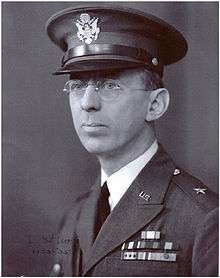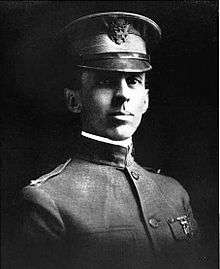Charles D. Herron
Charles Douglas Herron (March 13, 1877 – April 23, 1977) was a decorated Lieutenant General in the United States Army. A graduate of the United States Military Academy at West Point, he participated in the Spanish–American War and both World Wars.
Charles Douglas Herron | |
|---|---|
 Charles D. Herron as a brigadier general | |
| Born | March 13, 1877 Crawfordsville, Indiana |
| Died | April 23, 1977 (aged 100) Honolulu, Hawaii |
| Place of burial | Oak Hill Cemetery, Crawfordsville, Indiana |
| Allegiance | |
| Service/ | |
| Years of service | 1899–1941; 1942–1946 |
| Rank | |
| Commands held | Hawaiian Division Hawaiian Department VI Corps |
| Battles/wars | Spanish–American War World War I World War II |
| Awards | Distinguished Service Medal (2) |
Early career
Herron was born in Crawfordsville, Indiana on March 13, 1877. He was the son of William Parke Herron (1843–1927), a captain in the Union Army during the Civil War.
Herron attended Indiana's Wabash College and was a member of the Beta Theta Pi fraternity before accepting appointment to the United States Military Academy at West Point, from which he graduated in 1899. Herron was appointed a Second Lieutenant of Infantry, and served in the Philippines during the Philippine Insurrection. He then carried out a series of increasingly demanding assignments, including Professor and Assistant to the Quartermaster at West Point, Instructor and Inspector of the Indiana National Guard, Adjutant of the 10th Infantry Regiment in Panama, and commander the 10th Infantry's Machine Gun Company. In 1908 he received a master's degree from Wabash College.
World War I

During World War I Herron served as deputy chief of staff of the 1st Division and chief of staff of the 78th Division, participating in the Meuse-Argonne Offensive and the occupation of Saint-Mihiel. The governor of Indiana appointed him as a brigadier general in the National Guard, intending to have him command troops from that state, but Herron could not procure a discharge from the Regular Army and remained on active duty. At the end of the war his sustained superior efforts were recognized with the Distinguished Service Medal.
After the war he attended the Army War College, served on the General Staff in Washington, and was assigned as chief of staff of the Philippine Department, headquartered in Manila.
From 1934 to 1935 Herron was the Army's Executive for Reserve Affairs, receiving promotion to brigadier general. From 1935 to 1937 he was commander of the 6th Field Artillery Regiment. In 1937 he earned a law degree from Wabash College and was promoted to major general as acting VI Corps commander and then commander of the Hawaiian Division.
Later career
As head of the Army's Hawaiian Command from 1938 to 1941, Herron was promoted to lieutenant general and bucked Army conventional wisdom by advocating for the integration of Japanese-Americans into the Organized Reserves, reasoning that their citizenship trumped their ancestry. While his stance ran counter to public opinion, he was credited with helping keep Japanese-Americans in Hawaii from being interned at the start of World War II, as happened in California and other Western states. Herron also documented his concern about the military's ability to defend Hawaii, citing its vulnerability to attack by carrier based aircraft. After the attack on Pearl Harbor, Herron provided evidence during the inquiry into the conduct of his successor, General Walter C. Short, stating that prior to Short's arrival he had provided General Short with a briefing book and other materials about the current situation in Hawaii, and that Short had acknowledged not having had time to read them before Herron departed.
Herron retired in early 1941, but was recalled in 1942, serving on the Personnel Board that considered officers for promotion. He retired again in December 1946, receiving a second Distinguished Service Medal.
Later years
From 1946 to 1966 Herron resided in Bethesda, Maryland, where he was active in civic affairs and served on the Montgomery County Court of Tax Appeals.
In 1966 his wife and he moved to Hawaii to live near their daughter, and Herron died on April 23, 1977 at the Honolulu nursing home where he had resided for several years. General Herron was buried in Crawfordsville's Oak Hill Cemetery.
The Charles Herron Papers (1908–1949) are part of the collections of the Wabash College Library. The Charles D. Herron Photograph Collection (1899–1941) is preserved at the U.S. Army Military History Institute at Carlisle Barracks, Pennsylvania.
Family
His sister Jessie was the wife of Will H. Hays (1879–1954), Republican National Committee Chairman, U.S. Postmaster General and President of the Motion Picture Producers and Distributors of America (MPPDA), later named the Motion Picture Association of America (MPAA).
Awards
- Distinguished Service Medal with oak leaf cluster
- Philippine Campaign Medal
- Mexican Border Service Medal
- World War I Victory Medal
- American Defense Service Medal
- American Campaign Medal
- World War II Victory Medal
Citation for first Distinguished Service Medal:
- The President of the United States of America, authorized by Act of Congress, July 9, 1918, takes pleasure in presenting the Army Distinguished Service Medal to Colonel (Field Artillery) Charles D. Herron, United States Army, for exceptionally meritorious and distinguished services to the Government of the United States, in a duty of great responsibility during World War I, as chief of staff, 78th Division, during the Meuse-Argonne offensive.
- Service: Army Rank: Colonel War Department General Orders No. 59 (1921)
References
- "Charles D. Herron". Biographies of Commanding Generals. US Army Pacific Command. Archived from the original on 2011-06-16. Retrieved 2009-12-04.
- Cullum, George W. (1901). Biographical Register of the Officers and Graduates of the U.S. Military Academy at West Point, Supplement, Volume IV.
- The Beta Theta Pi. Beta Theta Pi. 1901. p. 221.
- Esarey, Logan (1918). A History of Indiana From 1850 to the Present, Volume 2. p. 1084.
- Clausen, Henry C.; Bruce Lee (2001). Pearl Harbor: Final Judgement. New York City: Crown Publishers. pp. 183–184. ISBN 0-517-58644-4.
- Okihiro, Gary Y. (1992). Cane Fires: The Anti-Japanese Movement in Hawaii, 1865-1945. p. 149.
- Dye, Bob, ed. (2000). Hawai'i Chronicles III: World War II in Hawai'i. p. 34.CS1 maint: extra text: authors list (link)
- "Hawaiian Post to Herron: Army Names Him to Succeed to Department Command". The New York Times. March 4, 1938. Retrieved 2009-12-09.
- "Lieut. Gen. Charles Herron, 100; Commanded Army Units in Hawaii". The New York Times. April 25, 1977. Retrieved 2009-12-09.
- "Movie 'Czar' Weds Widow of Diplomat". Hartford Courant. November 28, 1930. Retrieved 2009-12-09.
- "Mrs. Will H. Hays Dies: Widow of Former 'Czar' of Movie Industry Was 84". The New York Times. August 30, 1960. Retrieved 2009-12-09.
- "Distinguished Service Medal citation". Hall of Valor. Military Times. Archived from the original on 2013-01-29. Retrieved 2009-12-09.
Further reading
- Crowell, Thomas Irving (1920). A History of the 313th Field Artillery, U.S.A. New York City: Thomas Y. Crowell Co. Retrieved 2009-12-09.
- Hilkert, David E. (2004). Chiefs of the Army Reserve: Biographical Sketches of the United States Army Reserve's Senior Officers (PDF). Fort McPherson, GA: Office of Army Reserve History, U.S. Army Reserve Command. Archived from the original (PDF) on 2011-07-27. Retrieved 2009-12-11.
External links
- "Charles D. Herron". Find a Grave. Retrieved 2009-12-22.